Free Example of Construction Proposal Template: To make the construction project that gives you the best result, there are some details which should be correct from the beginning step to the end. The construction project should be right from the proposal and that’s why you always need good construction proposal template.
Many times, you need a legal officer to review your contract and confirmed whether that contract was designed according to the legal requirements of your state. It should not only write clearly but also it should be fair for all individuals and companies which involve in that project.
Detailed scope of construction proposal
A construction proposal isn’t just a simple document; it’s the foundation of a successful project. Understanding the importance of the detailed scope within this proposal is paramount for both the client and the contractor. Here’s why:
Defines the Work Boundary
The proposal must be specifically tailored to outline the scope of your work. Defining the exact tasks and responsibilities ensures clarity about what is expected.
Protection Against Unplanned Work
A detailed scope will safeguard you from getting pulled into additional tasks not originally agreed upon. It acts as a shield against unexpected demands.
Clear Communication with the Client
Presenting your client with a well-crafted proposal ensures that both parties are on the same page. It defines expectations and sets a clear framework for the entire project.
Provision for Additional Charges
A comprehensive scope isn’t just about defining what is included; it’s also about specifying what isn’t. If there are extra tasks or changes midway, like adding items or addressing unforeseen conditions, you have a clear basis for charging for these additional works.
Common Extras in Construction:
- Adding Items: The client might want to include more features or elements after starting a project.
- Hidden Conditions: Unexpected issues like damaged structures or unforeseen ground conditions might arise once construction starts.
- Mid-Project Changes: Occasionally, clients might change their minds about certain aspects of the project after it’s already underway.
A detailed scope in a construction proposal doesn’t just protect you—it also ensures transparency and fairness for all parties involved. By laying everything out clearly, the contractor and the client can confidently move forward, knowing they have a mutual understanding.
The elements in the construction proposal
A good construction proposal should protect you, your company and your interests as well. There are some important elements that should be included in construction contract and they can end up in serious condition if they were ignored.
The scope of your project
This is really mandatory in any construction contract, especially the necessary elements in a more detailed explanation. In great detail, then the part in your proposal should be highlighting the services will be offered by each party involved. It should be a brief transcription of schedule, work, quality, materials, and other features or even other descriptions that needed to see throughout this construction project.
The identities of the parties involved
This is essential things which should be obvious and is often ignored by many newbies. But the identities of parties which involved should be present in this proposal because this is how it becomes the legally binding document. It should mention signatures, names, address all of the parties involved. If those things were not mentioned and in a poor manner, this is impossible to make that contract hold or even considered as the binding contract in the court. So there are many things that you have to understand.
Mention cost and terms of your payment
This is a very important thing of your proposal because it will highlight the cost of services will be given and other costs which might run out of the project scope. It should be a clear indication related to payment schedules or the amounts should be clear on the specific milestone and any condition and term which guarantee the release of those payments.
Use relevant authority
These projects are big and for this reason, there are some small projects which were undertaken in the bigger projects. The completion will make whole projects come to the fruition. This is very important to highly the different parties who will be under the authority in different project stages and have the legal authority to enter the legal binding commitment in every stage. It should be set up even before you start your project.
The work schedule
Your work schedule should give you a notice on how the project will start and when it will end as well. This schedule gives you with the date when the contractor receives the notification to continue that project. At the same time, this is also mandatory to show you on how far of the contractor’s liability in the construction proposal. you have to understand the differences between the calendar days and your working days. It should be the determination for supplier lead times and you have to highlight how this schedule might affect your delivery schedule for the project and how much additional time that you need to calculate.
Shortly, this is a very simple feature, but without you have it, or if there is any error, you might end up with more confusions throughout your projects because there is no something clear about who must take that responsibility for the given job.
Why you need a construction proposal schedule
Having a clear plan is essential in every project. In the construction world, this is especially true. Here’s why you must have a construction proposal schedule:
Clarity and Direction
It’s easy to get lost without a schedule. A construction proposal schedule ensures that you have a clear roadmap for your project.
Monitor Progress
With a schedule, you can track the progress of each task. It helps ensure that you stay on course.
Resource Allocation
It allows you to allocate resources efficiently. You know when and where you need workforce, equipment, and materials.
Types of Schedules
Different construction sizes and complexities require different types of schedules:
Small Constructions:
- Simple Bar Chart: This basic representation of tasks and timelines.
Large Constructions:
- Detailed Plan: For more extensive projects, you’ll need a thorough plan outlining every task and deadline.
- Use of Apps: Some large projects might require specific software. These apps help manage multiple tasks simultaneously, ensuring everything runs smoothly.
A construction proposal schedule is more than just a document. It’s your guide to bringing your project to completion successfully. Recognize always to adjust and update your schedule as needed to reflect your construction’s real-time needs and progress.
Example of construction proposal template
Simple Construction Proposal Template
A basic and straightforward proposal format. It covers essential details without complex sections, making it user-friendly for quick project pitches.
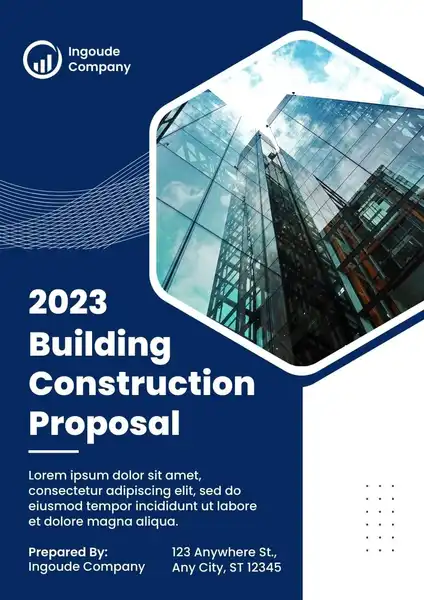
Professional Construction Proposal Template
A comprehensive and detailed template that gives an advanced, polished look. Ideal for larger clients or projects that require an in-depth proposal.
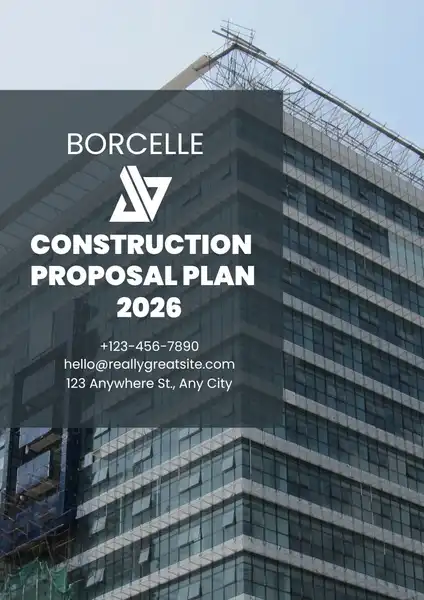
Residential Construction Proposal Template
Tailored specifically for home-building or renovation projects. This template includes sections relevant to residential construction needs.
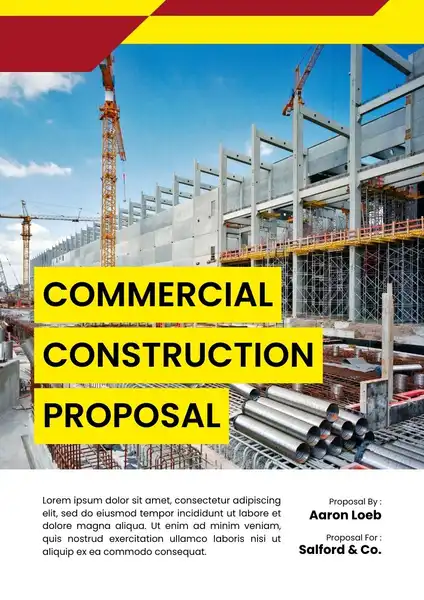
Printable Construction Proposal Template
Optimized for printing. This template maintains clarity and professionalism when transferred to a physical copy, making it perfect for in-person presentations.
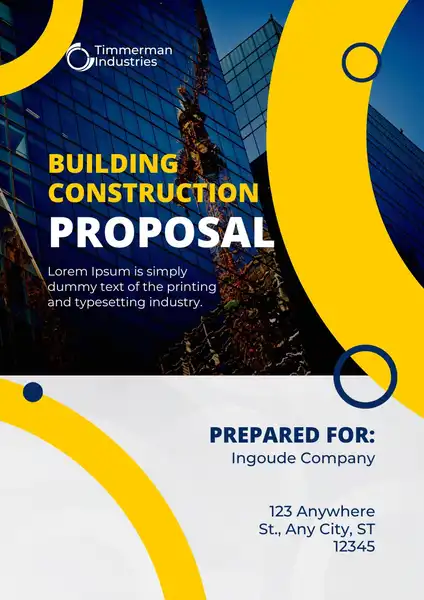
Pre-Construction Proposal Template
Designed for projects in the planning or initial phases. It highlights pre-construction services, feasibility studies, and preliminary budget estimates.
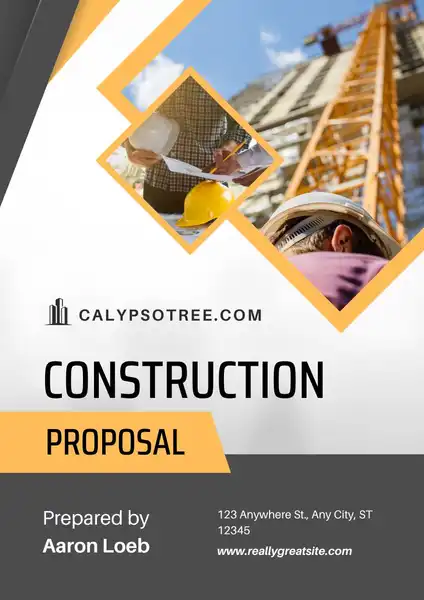
Construction Proposal Template Word
A text-based template crafted in Microsoft Word. It offers pre-defined sections detailing project specifics, making it easy to customize and present to clients.
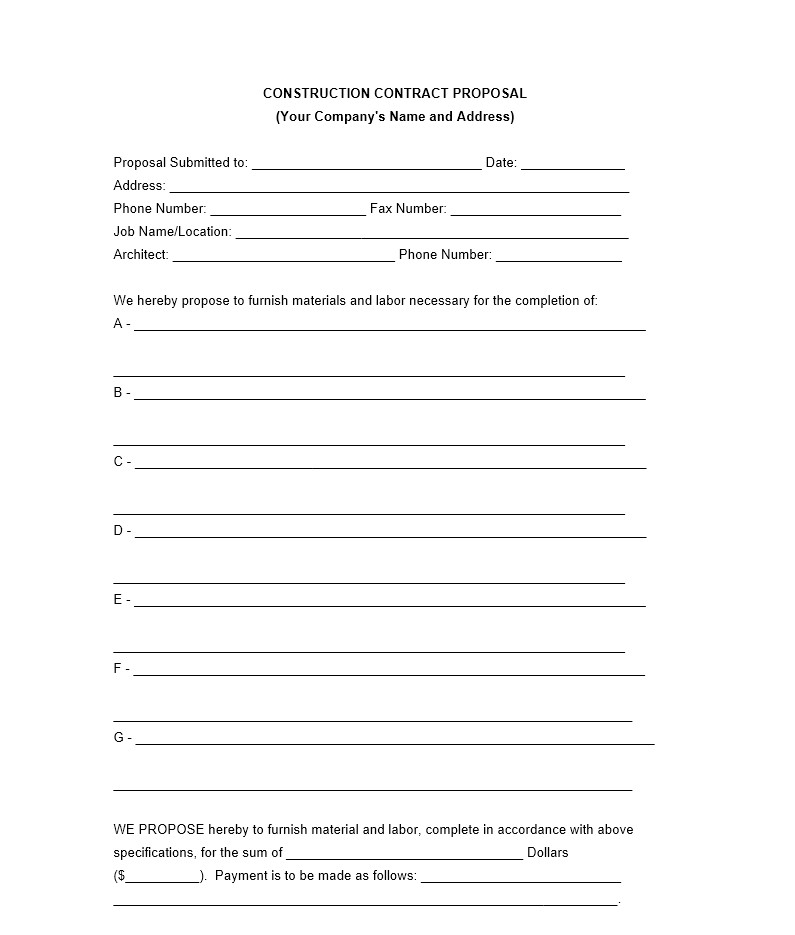
Concrete Construction Proposal Template
Focused specifically on projects involving concrete work. It includes details about materials, labor, and other specifics related to concrete construction.
Construction Proposal Template Excel
An interactive spreadsheet template designed in Excel allows users to input project details, costs, and timelines. Ideal for organizing and calculating construction-related data automatically.
Construction Proposal Template Pdf
A fixed-layout document format ideal for sharing and printing. Offers a professional look and ensures consistent formatting across different devices.
Construction Proposal Template Google Docs
An online-based template was accessible via Google Docs. Perfect for real-time collaboration, edits, and sharing with clients or teams.
These templates serve unique needs and provide that professionals in the construction industry can present their projects efficiently and effectively.
How to Write an Effective Construction Proposal
Creating a construction proposal is paramount for winning bids and setting clear expectations for the client and the contractor. Here’s a step-by-step guide to ensure your proposal stands out:
Title Page
- Start with a professional-looking title page. Include your company’s name, logo, contact information, the project’s name, and the date.
Executive Summary
- Offer a brief overview of the project. Highlight the main objectives and the solutions you’re proposing.
Project Details
- Scope of Work Clearly defines the boundaries of the project. Describe in detail the tasks to be undertaken.
- Site Information Mention any critical site-specific information, potential challenges, or requirements.
- Duration Provide a timeline indicating the start and finish dates.
Materials and Labor
- List of Materials Specify all materials needed, their quality, and potential suppliers.
- Labor Breakdown Detail the workforce required, their roles, and the duration of their tasks.
Pricing and Payment Terms
- Itemized Costs Break down the costs for materials, labor, and other expenses.
- Payment Schedule Define how and when payments should be made, such as upfront deposits, progress payments, or upon completion.
Terms and Conditions
- Set clear terms, including warranty details, penalties for delays, or any other contractual obligations and rights.
Licenses and Permits
- Highlight any necessary licenses your company holds and permits required for the project.
Project Management and Reporting
- Describe how the project will be managed, the communication lines with the client, and the frequency of progress reports.
References and Testimonials
- Boost your credibility by adding references from past clients or testimonials that vouch for your work’s quality.
Attachments and Appendices
- Add any relevant blueprints, sketches, or documents supporting your proposal.
Conclusion and Call to Action
- Summarize your proposal’s main points and encourage the client to take the next steps, such as getting in touch or signing the agreement.
Signature Section
- Provide a space for both parties to sign, indicating agreement and acceptance of the proposal.
Final Tips
- Always use clear and straightforward language to ensure comprehension at all levels.
- Bold important information to draw attention.
- Use list tables where necessary to organize data.
- Proofread the proposal multiple times to avoid any errors.
- Ensure the proposal is tailored for each client, demonstrating understanding and consideration of their unique needs.
A construction proposal not only presents your plan but also establishes trust and professionalism in the eyes of the client.
Importance of a Construction Proposal
Here’s why a construction proposal is of paramount importance:
Clear Communication
The contractor’s understanding of the client’s needs and expectations.
Establishes Professionalism
Presenting a well-structured and detailed establishes a sense of professionalism. It reflects the contractor’s dedication, attention to detail, and commitment to quality work.
Binding Agreement
Once accepted and signed, It often becomes a contractual document.
Detailed Cost Breakdown
Provides an itemized breakdown of costs, from labor to materials.
Project Timeline
Presents a clear project timeline from start to completion. It allows the client to plan accordingly and set clear project progress benchmarks.
Risk Management
Outlining potential risks and challenges and their mitigation strategies shows foresight and preparedness. It ensures both parties are aware of potential hurdles and the solutions in place.
Trust and Credibility
References, testimonials, and past project details can boost contractors’ credibility, helping them secure the project over competitors.
Scope Definition
Clearly defining the project’s scope prevents “scope creep” – adding tasks not originally agreed upon. It ensures the contractor is compensated for extra work and that clients understand boundaries.
Terms and Conditions
spells out the specific terms and conditions of the project, including payment terms, warranties, and any penalties or incentives based on performance. This clarity helps prevent future disputes.
Documentation and Record
Beyond its immediate purpose, It is a historical record of agreements and understandings. It can be invaluable in future discussions or case of any disagreements.
Common Mistakes to Avoid
Here are some common mistakes to avoid:
Vague Descriptions
Mistake: Providing unclear or generic project descriptions.
Solution: Offer detailed, precise descriptions of tasks, materials, and the overall project scope.
Incomplete Pricing Details
Mistake: Leaving out specific costs or not itemizing expenses.
Solution: Break down all costs clearly, ensuring no hidden charges exist.
Lack of Visuals
Mistake: Not including blueprints, sketches, or visual aids.
Solution: Enhance your proposal with relevant images, charts, and diagrams.
Forgetting the Timeline
Mistake: Missing a project timeline or offering a vague one.
Solution: Specify clear start and end dates, and provide milestones.
Overlooking Terms and Conditions
Mistake: Not defining the contractual obligations, rights, and penalties.
Solution: Clearly state all terms and conditions to avoid future disputes.
Not Tailoring to the client
Mistake: Using a one-size-fits-all approach.
Solution: Customize each proposal to address the specific needs and concerns of the client.
Ignoring Potential Challenges
Mistake: Not acknowledging potential obstacles or risks.
Solution: Address foreseeable challenges and provide solutions or contingency plans.
Grammatical and Typographical Errors
Mistake: Overlooking small mistakes in the text.
Solution: Proofread multiple times and consider using grammar-checking tools.
Missing References
Mistake: Not including any testimonials or past client references.
Solution: Boost credibility by adding testimonials and offering references upon request.
Failing to Use Clear Language
Mistake: Using jargon or overly complex language.
Solution: Write in simple, understandable terms to ensure clarity for all readers.
Overpromising
Mistake: Promising results that might be unrealistic or beyond capacity.
Solution: Be honest and realistic in your proposals to build trust and maintain your reputation.
Not Providing a Signature Section
Mistake: Forgetting to include a place for both parties to sign.
Solution: Always have a signature section indicating mutual agreement.
FAQs
What is a construction proposal template?
It is a formal document presented by a contractor to a potential client outlining the scope of work, costs, timeline, and terms for a specific construction project.
How is a construction proposal different from a construction estimate?
While both documents provide details about costs, a proposal is more comprehensive. An estimate gives a rough idea of costs, whereas a proposal outlines the project scope, timeline, materials, terms, and conditions.
How long is a construction proposal valid?
The validity period can vary but is typically specified in the proposal. Common periods range from days, after which the terms, especially costs, might be subject to change.
Can I negotiate a construction proposal?
Before accepted and signed, both parties can discuss and adjust terms, costs, or timelines to reach a mutually beneficial agreement.
What happens after a proposal is accepted?
Once both parties sign the proposal, it often becomes a contractual document. Work then begins based on the outlined terms, with adherence to the stated timeline, costs, and project specifications.
What should I do if the actual project deviates from the proposal?
It’s essential to address any deviations immediately. Changes should be documented, and if they result in additional costs or timeline adjustments, a change order or an addendum to the original proposal may be necessary.
Do I need to include licenses and permits in the proposal?
It might mention that the contractor will handle necessary licenses and permits; the documents might need to be included. However, it’s a good practice to specify who obtains them.
What if there are unexpected costs during construction?
It should outline procedures for unexpected expenses. Typically, any additional costs require client approval, and a formal change order is issued.
How can I ensure the construction proposal is clear and understandable?
Use bolded words to emphasize critical points, include list tables for organized data presentation, and maintain a readability level suitable for all, like Grade for broader understanding.
What happens if one party breaches the proposal terms?
It should outline consequences for breaches, including penalties, resolution processes, or potential legal actions.

The content creator team at calipsotree.com is dedicated to making topics accessible to everyone, with over 9 years of experience in writing and breaking down complex concepts into easy-to-understand articles that answer readers’ financial questions.








